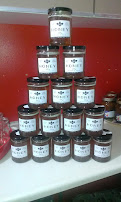The end of August is possibly the best time in the beekeeping year – it’s time to extract the honey! Here are a few photos from when Stewart and I gathered the harvest.

Firstly, we need to “uncap” the honeycomb. This involves running a sharp knife along the surface of the comb, to remove the thin wax caps that the bees use to cover each of the honey-filled hexagonal cells. The cappings fall to the bottom of the tray. There’s still some honey adhering to the wax, and we don’t want to waste it, so we keep the cappings in the tray now, and will come back to them later. After they’ve been uncapped, the frames of honey are placed into the extractor. This is a simple centrifuge inside a steel drum – when the handle is turned, the frames spin inside the cradle, and the centrifugal force sends the honey out of the comb and onto the side of the drum. The honey then trickles down to the bottom.

|

|
 |
 |

Next is my favourite part – opening the tap on the extractor, and watching the honey flow out! It falls into a filtration bucket, which has a fine mesh on the top – this filters out any bits of wax (and the odd stray bit of wing or leg…) so that the end result will be pure honey.
 |
Nothing wasted
|
Remember the wax cappings? After the honey has flowed through the filter, I put the cappings on top of the filter – this allows any remaining drops of honey to dribble off the cappings and into the bucket. Once I’ve got as much as I can, I take the cappings out and wash them. The wax can then be used to make candles or furniture polish.

The last job – open the tap on the filtration bucket, and fill the jars. Then label them up, and we have a finished batch of delicious local “Beechen Bees” honey.





 Next is my favourite part – opening the tap on the extractor, and watching the honey flow out! It falls into a filtration bucket, which has a fine mesh on the top – this filters out any bits of wax (and the odd stray bit of wing or leg…) so that the end result will be pure honey.
Next is my favourite part – opening the tap on the extractor, and watching the honey flow out! It falls into a filtration bucket, which has a fine mesh on the top – this filters out any bits of wax (and the odd stray bit of wing or leg…) so that the end result will be pure honey.
 The last job – open the tap on the filtration bucket, and fill the jars. Then label them up, and we have a finished batch of delicious local “Beechen Bees” honey.
The last job – open the tap on the filtration bucket, and fill the jars. Then label them up, and we have a finished batch of delicious local “Beechen Bees” honey.